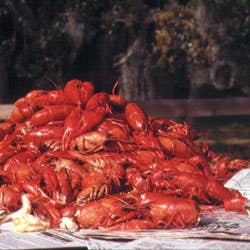
One of the many legends of Acadiana: When the Acadians left Nova Scotia for Louisiana in the mid-18th century, a gaggle of North Atlantic lobsters followed them south to the bayous. Along the way, they molted repeatedly, each time acquiring smaller shells. By journey's end, they had become crawfish. If the crustaceans' transformation was an expression of sympathy for the Acadians, though, that compassion has not been reciprocated: Generations of Acadian cooks have tossed millions of crawfish into boiling cauldrons, stewpots, saute pans—even, in modern times, empty ice chests used as makeshift steamers.
The center of the crawfish universe is Breaux Bridge, Louisiana, birthplace of the most celebrated crawfish creation of all, crawfish etouffee—crawfish tails long-cooked in a lidded black iron pot with onions, cayenne, and crawfish fat, among other ingredients. According to local restaurateur Dickie Breaux, the dish was invented here in the late 1920s, in the old Hebert Hotel, by Mrs. Charles Hebert and her daughters, Yolie and Marie. The Hebert sisters passed the recipe on to their friend Aline Guidry Champagne, who served the dish at her Rendez-Vous Cafe, also in Breaux Bridge. Champagne dubbed it "etouffee," French for "smothered," a reference to its long cooking in a lidded pot.
Champagne in turn gave the recipe to her father, Henry Guidry, who served it—and other crawfish preparations—at his own restaurant, Guidry's Place, in nearby Henderson Landing. Guidry's was a maze of small private dining rooms that allowed locals to indulge in crawfish undetected: The crustacean was considered a lowly, inedible scavenger—hardly the sort of thing gentlefolk ate in public.
Keep Reading
Continue to Next Story










